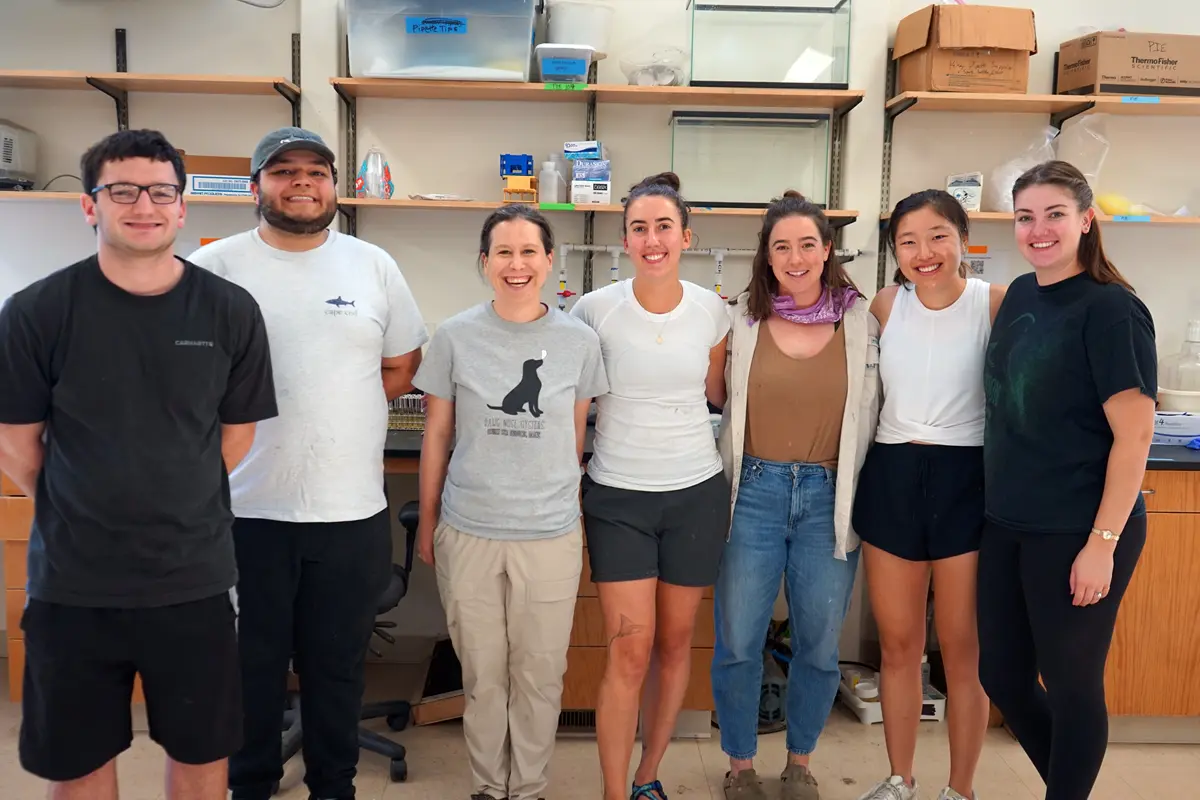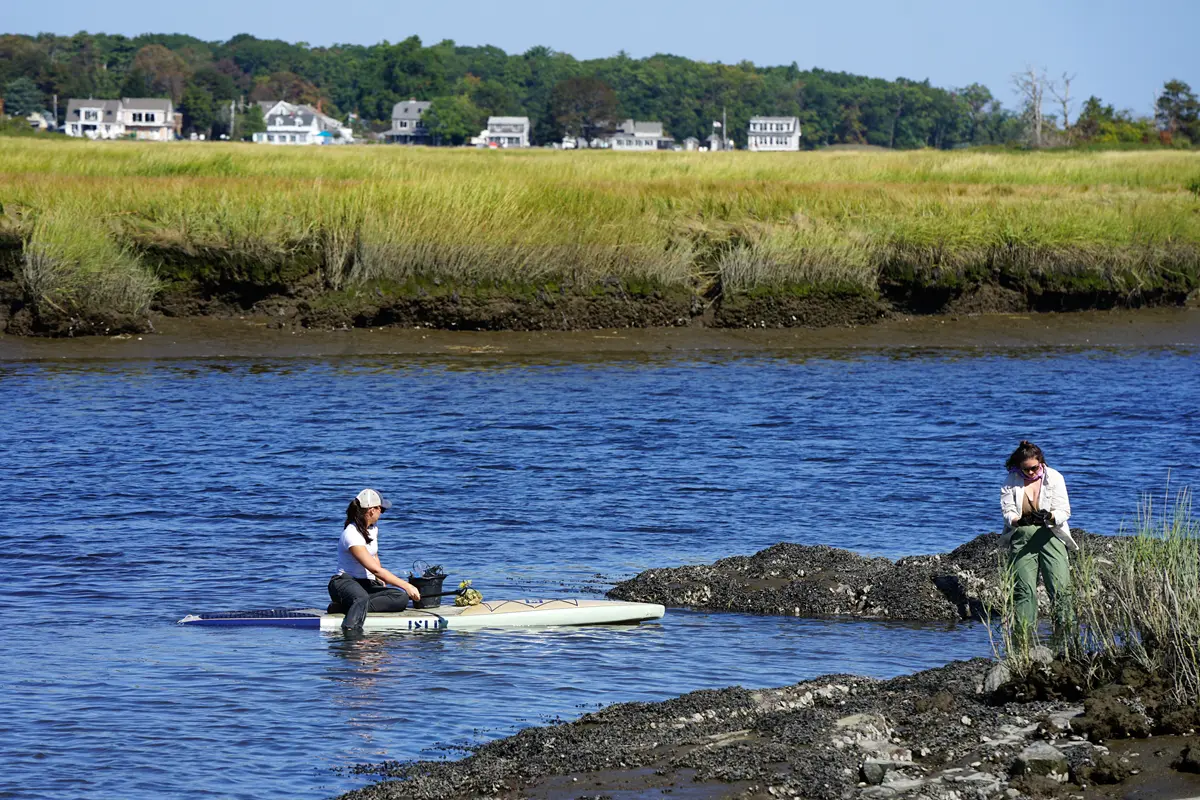Julia McDonough has never eaten an oyster, but she spends plenty of time with them.
On a recent Sunday morning, the third-year applied biology doctoral student hopped on a paddleboard and navigated her way to an oyster farm on a tidal creek in Rowley, about 30 miles north of Boston. Pulling up alongside a line of floating oyster cages, McDonough reached underwater and retrieved a mesh bag of the saltwater bivalve mollusks from one of the cages.
Meanwhile, over on the shoreline, Biological Sciences Assistant Professor Sarah Gignoux-Wolfsohn and lab technician Felicia Aronson waded into the creek to collect about two dozen wild oysters.
The trio then took their collective haul, along with water samples from the creek, to a nearby lab in Byfield that’s managed by the Plum Island Ecosystems Long Term Ecological Research program. There, four more members of Gignoux-Wolfsohn’s research team — doctoral student Jade Fiorilla and undergraduate biology majors Morgan Cairns, Anthony Grossi and Jake Skehan — were waiting to get to work.
For the next several hours, they shucked, dissected and analyzed the oysters for a long-term research project that examines the health and genetics of Massachusetts’ wild and farmed oyster populations. The work is part of Gignoux-Wolfsohn’s broader mission to understand how oysters — and the ecosystems they support — are responding to climate change.
 Image by Ed Brennen
Image by Ed Brennen
Biological sciences Assistant Professor Sarah Gignoux-Wolfsohn, third from left, poses with members of her research team, from left, Jake Skehan, Anthony Grossi, Julia McDonough, Felicia Aronson, Jade Fiorilla and Morgan Cairns.
Before joining UMass Lowell in 2022, Gignoux-Wolfsohn studied oysters in the Chesapeake Bay as part of a postdoctoral fellowship at the Smithsonian Environmental Research Center in Maryland. When she moved to Massachusetts, she found that wild oysters had been largely overlooked in the Northeast.
“Soft-shell clams are a big thing on the North Shore, but no one knows where the wild oysters are. It’s kind of the Wild West in some ways,” she says.
With help from Fiorilla, who grew up on nearby Plum Island, Gignoux-Wolfsohn talked to local residents and identified three wild oyster beds along the Rowley River and Mud Creek in the Great Marsh, a roughly 25,000-acre salt marsh that stretches from Salisbury to Gloucester. The team also connected with two local oyster farms, Great Marsh Shellfish and Mud Creek Shellfish.
Starting in June, the team began monitoring oysters and the diverse fish and crabs that use their reefs for habitat at the five sites. Temperature loggers track water conditions, while lab analyses focus on genetics, parasites and microbiomes — the communities of microbes that live inside the oysters’ tissues.
 Image by Ed Brennen
Image by Ed Brennen
Senior biology major Morgan Cairns, left, filters water samples from the creek for microbiomes.
“If wild and farmed oysters are living in the same estuary but have different microbes, that could tell us something about how environment or farming practices shape resilience,” says Fiorilla, who got a tattoo of an oyster on her left shoulder when she joined Gignoux-Wolfsohn’s lab in 2024.
The Massachusetts project complements a large-scale study that Gignoux-Wolfsohn leads with colleagues at UMass Dartmouth and the Chesapeake Biological Laboratory in Maryland. Supported by a National Science Foundation grant of nearly $1.3 million, including more than $500,000 for UMass Lowell, the four-year project examines how repeated exposure to warming waters and low oxygen affects oyster health and gene function.
McDonough works on the molecular side of the Chesapeake project, studying how gene expression and DNA methylation shift under stress.
“We’re hoping to identify markers of resilience,” she says. “If early exposure to stress makes oysters stronger later on, that could help farmers create hardier stocks.”
The stakes are high: New England waters are warming faster than almost anywhere else in the world, which may increase the prevalence of oyster parasites such as Perkinsus marinus, a microscopic organism that weakens oysters but doesn’t affect humans.
Grossi, a senior from Stoneham, focuses on detecting Perkinsus in both wild and farmed oysters.
 Image by Ed Brennen
Image by Ed Brennen
Ph.D. student Julia McDonough, left, brings a bag of farmed oysters to shore while lab technician Felicia Aronson looks for wild oysters on the banks of Mud Creek.
Cairns, a senior from Chelmsford who is also a Moloney Scholar, studies larger oyster parasites such as blister worms and boring sponges.
“I love the fieldwork and the lab work, and I love learning about something that kind of gets overlooked,” she says. “A lot of people just eat oysters, but learning how our environment and other organisms affect them is really fun.”
For Gignoux-Wolfsohn, involving undergraduates is central to the project.
“There’s a huge difference between looking at pictures of animals versus actually being out in the ecosystem and seeing the animal in its natural habitat,” she says. “And it’s cool to get the undergrads connected with the farmers — the people who are influenced by the real-world applications of our science.”
The team will pause its fieldwork for the winter, but plans to resume next summer.
That gives McDonough some time to muster up the courage to try eating one of her briny research subjects.
“I know too much about them at this point,” she says with a laugh. “But I’m afraid Sarah won’t let me graduate until I try one.”
